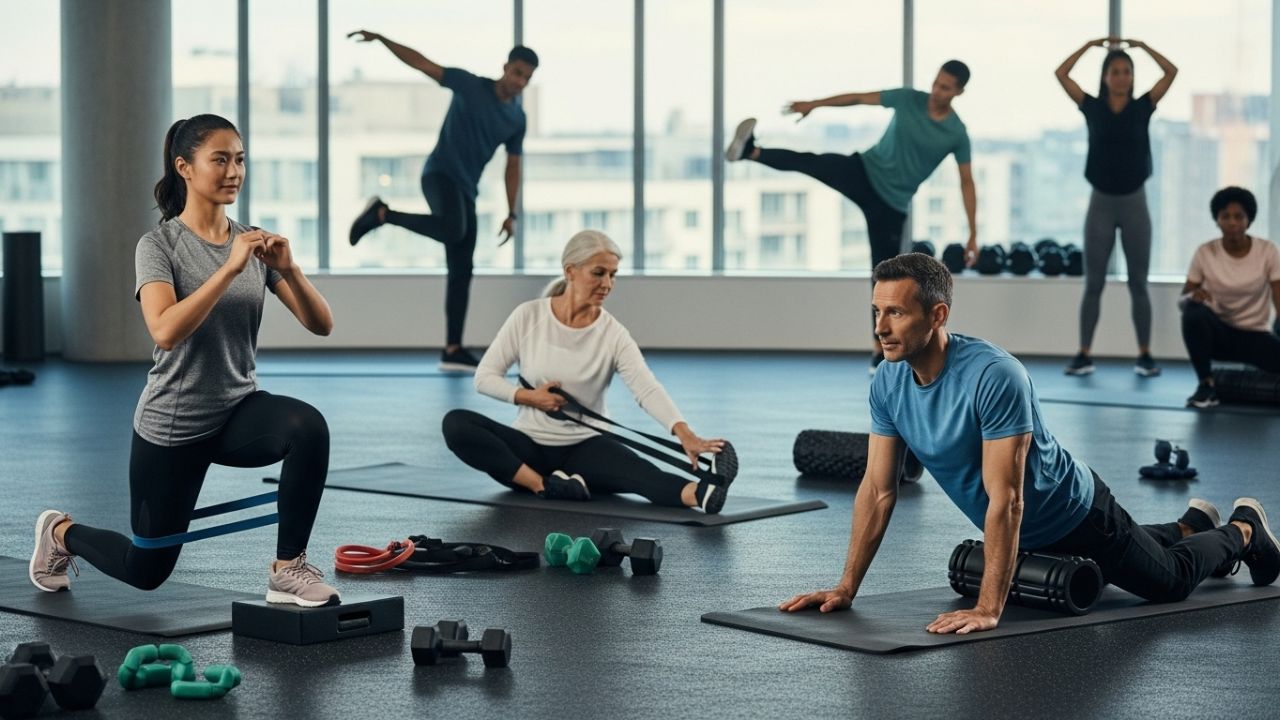Mobility Training Exercises: Improve Flexibility and Movement Naturally
In today’s fast-paced world, where many of us spend hours sitting at desks, using smartphones, or commuting, our joints and muscles often become stiff and less flexible. This is where mobility training exercises come to the rescue. Mobility is more than just stretching it’s about improving your body’s ability to move freely and efficiently through its full range of motion.
Whether you are an athlete, a fitness enthusiast, or someone who simply wants to move without stiffness and discomfort, mobility exercises for beginners can transform the way your body feels and performs. In this detailed guide, you’ll learn what mobility training is, why it matters, and how to perform full body mobility exercises step by step.
What Are Mobility Training Exercises?
Mobility training exercises are dynamic movements designed to improve joint health, flexibility, and overall movement quality. Unlike static stretching, which focuses on holding a position, mobility exercises involve active movement to increase the range of motion in your joints.
For example:
- Moving your arms in big circles to warm up your shoulders.
- Rotating your hips to loosen tight muscles before a workout.
- Performing controlled squats to improve ankle, knee, and hip flexibility.
These exercises prepare your body for physical activities, prevent injuries, and promote better posture.
Why Are Mobility Training Exercises Important?
Mobility isn’t just for athletes it’s essential for everyone. Here’s why incorporating mobility training exercises into your daily routine is a game changer:
- Reduces Joint Stiffness – Sitting for long hours leads to tight hips, shoulders, and back. Mobility exercises release this tension.
- Improves Flexibility and Range of Motion – Essential for performing workouts safely and effectively.
- Prevents Injuries – Warm, mobile joints are less likely to suffer from strains or tears.
- Enhances Athletic Performance – Better mobility means better lifting form, running posture, and overall body control.
- Supports Healthy Aging – Maintaining mobility helps you stay active and independent as you grow older.
Why Are Mobility Training Exercises Important?
If you are new to mobility training, start with simple movements. These mobility exercises for beginners are low-impact, easy to perform, and perfect for daily practice.
1. Neck Circles
- Sit or stand tall.
- Gently rotate your head in a circular motion—clockwise for 5 reps, then counterclockwise for 5 reps.
- Eases tightness and discomfort in the neck and upper back.
2. Shoulder Rolls
- Stand with feet shoulder-width apart.
- Gently rotate your shoulders forward and backward in wide circular motions.
- Repeat 10 times in each direction.
3. Cat-Cow Stretch
- Start on your hands and knees.
- Arch your back (cat) and then drop your belly while lifting your head (cow).
- Perform 8–10 repetitions.
4. Hip Circles
- Keep your posture upright and rest your hands on your hips.
- Rotate your hips in wide circles—5 reps each side.
- Loosens up tight hip joints caused by sitting.
5. Ankle Circles
- Lift one foot off the ground.
- Rotate your ankle clockwise and then counterclockwise.
- Repeat 8–10 times per foot.
These mobility exercises for beginners take just 5–10 minutes and prepare your body for more dynamic movements.
Full Body Mobility Exercises for Daily Routine
For those ready to take their mobility to the next level, try these full body mobility exercises that engage multiple joints and muscles simultaneously.
1. World’s Greatest Stretch
- Move into a forward lunge position with your right leg leading.
- Place your left hand on the ground and rotate your torso, reaching your right arm toward the sky.
- Hold for 3 seconds, switch sides, and repeat 5–6 times.
2. Deep Squat Hold
- Stand with feet slightly wider than hip-width.
- Lower into a deep squat while keeping your heels on the ground.
- Hold for 20–30 seconds, then rise.
- Improves ankle, hip, and knee mobility.
3. Thoracic Spine Rotations
- Sit on your heels or stand.
- Place your hands behind your head and slowly rotate your upper body left and right.
- Perform 8–10 reps per side.
4. Arm Swings with Torso Twist
- Stand with feet shoulder-width apart.
- Swing both arms across your body while gently twisting your torso.
- Repeat for 30 seconds.
5. Dynamic Hip Flexor Stretch
- Kneel on one knee with the other foot forward.
- Push your hips slightly forward and return to starting position repeatedly for 10 reps per side.
These full body mobility exercises not only prepare your body for workouts like strength training, yoga, or running but also improve everyday activities such as bending, lifting, or sitting comfortably.
How to Incorporate Mobility Training Exercises into Your Routine?
- Morning Routine: Start your day with 5–10 minutes of mobility exercises for beginners to wake up your joints.
- Pre-Workout Warm-Up: Perform full body mobility exercises before any strength or cardio session.
- Desk Breaks: Take short breaks during work to roll your shoulders, stretch your spine, or rotate your hips.
- Evening Wind Down: Gentle mobility drills can help relax tight muscles before bed.
Common Mistakes to Avoid in Mobility Training
Even though mobility work looks simple, many people make these mistakes:
- Doing static stretching only: Mobility is about movement, not holding a pose for minutes.
- Skipping it before workouts: Cold, stiff joints increase the risk of injury.
- Overdoing it: Start slow, especially with mobility exercises for beginners.
- Neglecting certain areas: Hips, ankles, and thoracic spine are often the tightest but most ignored.
Benefits of Full Body Mobility Exercises for Everyone
- Athletes: Better movement patterns lead to more efficient lifts, sprints, and jumps.
- Office Workers: Reduced stiffness from prolonged sitting.
- Older Adults: Maintains independence and balance.
- Beginners: Enhances flexibility and prevents early workout injuries.
Advanced Mobility Training Exercises (For Progression)
Once you’re comfortable with the basics, try these challenging variations:
- Cossack Squats – Side-to-side deep squats that improve hip and groin flexibility.
- Inchworm Walkouts – Combines hamstring stretch with core activation.
- Scapular Wall Slides – Opens up the chest and strengthens upper back mobility.
These advanced moves turn mobility training exercises into a mini workout for strength, flexibility, and joint health.
Move Better, Live Freer with Mobility Training Exercises
Mobility training exercises are not just an add-on they are an essential part of a healthy, pain-free, and active life. By including mobility exercises for beginners and gradually progressing to full body mobility exercises, you can:
- Improve flexibility
- Reduce stiffness
- Prevent injuries
- Enhance daily performance
Start small, stay consistent, and enjoy the freedom of effortless movement. Just 10–15 minutes daily can transform how your body feels whether at the gym, office, or home.
Frequently Asked Questions
Mobility training exercises are dynamic movements designed to improve joint flexibility, increase range of motion, and enhance overall movement efficiency. Unlike static stretches, they involve active movement that prepares your body for workouts, sports, and daily activities.
Stretching often involves holding a single position to lengthen muscles, while mobility exercises focus on moving your joints through their full range of motion. Mobility is more dynamic and functional, making it ideal for warm-ups and injury prevention.
Absolutely! Mobility exercises for beginners are simple, low-impact, and easy to perform at home or at the gym. They don’t require heavy equipment and can be done in just 5–10 minutes a day.
For best results, aim to practice mobility training exercises daily or at least 3–4 times a week. Consistency helps reduce stiffness, improve posture, and prevent injuries over time.
Yes, regular full body mobility exercises can reduce stiffness, improve circulation, and support joint health, which may help alleviate mild back or joint discomfort. However, consult a professional if you have chronic pain or injuries.

